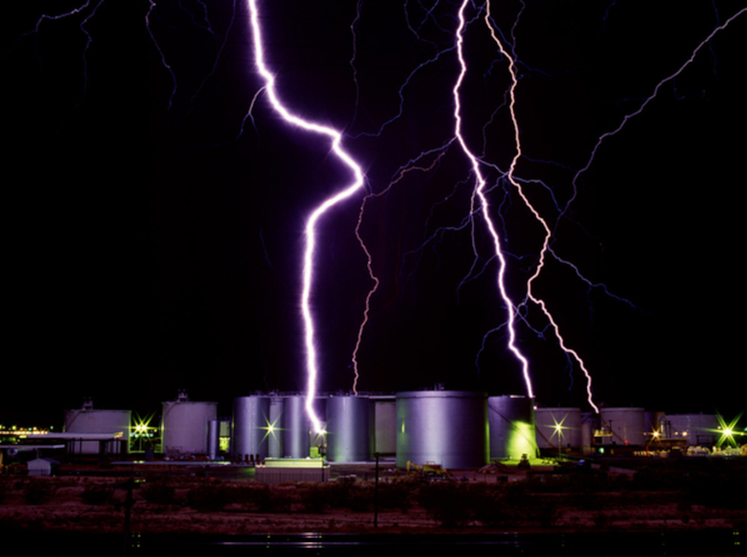Tank Ignition Source Management: Protecting Storage Tanks from Fires Due to Lightning Strikes
With Contributing Author –
Above ground storage tanks (AST) are widely used for the storage of large volumes of flammable liquids in tank farms, depots, and terminals. It is mission critical to effectively manage all ignition sources around and in the proximity of AST due to the high risk of fire escalation that can consume all the product in the tank and spread to adjacent tanks. The effective management of ignition sources is based on the fire triangle considerations for different scenarios in AST operations. Lighting strikes, static electricity and pyrophoric materials are scenarios that will be covered as Parts 2 and 3 in our series: Tank Ignition Source Management.

Part 1 – Protecting Storage Tanks from Fires Due to Lightning Strikes
Lightning is a common complex natural phenomenon which is estimated to occur approximately 1.4 billion times a year. Lightning can occur between opposite electrostatic charges which have accumulated between a cloud and the ground. The potential voltage difference can be between 10 to 100 million volts, and the peak currents typically are about 30,000 amperes. Direct-stroke lightning can cause direct ignition of flammable materials, and severely damage objects in its path through a combination of heat and mechanical force. In addition to direct ignition, lightning can cause secondary sparking on equipment that is relatively remote from the direct lightning strike.
Even when all known precautions are employed, prevention or safe dissipation of direct-stroke lightning cannot be absolutely assured.
Mitigation of the Hazard
Construction and operation of tanks consistent with industry standards and recommended practices effectively reduces the risk of tank fires caused by lightning strike.
A vast majority of lightning strike induced tank fires have been caused by tank design, operation and or maintenance practices that were not consistent with industry standards and recommended practices. These deficiencies resulted in a fire when a direct or near lightning strike occurred.
While the lightning strike likely could not have been avoided, deficiencies resulted in a flammable atmosphere being present where none should exist and or an electrical arc due to faulty bonding and grounding between tank components. If these conditions did not exist a fire would likely not have occurred.
Actions to Consider
Fixed roof tanks
- Equip vents with flashback devices, such as pressure vacuum vent valves and or flame arrestors. Include routine inspection of pressure vacuum vent valves in operator rounds and maintenance inspections to ensure they are not stuck open. Flame arrestors must be inspected to avoid fouling and plugging.
- Survey roof openings to ensure appurtenances such as gauge hatches, are closed and secured.
- Inspect tank roofs for corrosion holes or thinned areas of tank roofs and promptly resolve deficiencies.
- Ensure tank is grounding and bonding consistent with industry practice.
External (Open) Floating roof Tanks
- Ensure roof is electrically bonded to shell. See API 545 for information recommended practices to for bonding between roof and shell.
- Implement an inspection program to verify good shunt-to-shell contact.
- Implement an inspection program of roof seals to minimize any flammable atmosphere above and below the roof /shell seal.
- Ensure there is no flammable atmosphere inside pontoons.
- Provide mechanical hold down of the pontoon covers.
- Inspect pontoon covers to ensure there is good metal-to-metal contact.
- Inspect pontoons for the presence of flammable vapors or liquids on a routine basis.
- Promptly resolve deficiencies.
- Avoid landing the floating roof in normal operations as a flammable atmosphere can develop beneath the roof when landed.
- Avoid initial filling of a tank when the roof is on its legs during a lightning storm.
- Ensure maximum product rundown temperature is established and enforced.
- When high vapor pressure components (C4 and C3) are rundown into the tank utilize a diffuser to ensure complete mixing to avoid excessive flammable vapor generation. Consider periodically measuring composition.
Internal Floating-roof Tanks
Internal floating-roof tanks with conductive external steel roofs are inherently protected against internal ignitions from lightning induced sparking by the Faraday-cage effect, therefore the floating roof does not require bonding to the shell or tank wall for lightning protection.
- Implement testing of the tank vapor space for combustibles on a routine basis to test seal effectiveness. Correct deficiencies to keep vapor space well out of the flammable range.
- Other than electrical bonding of the internal roof implement the recommended actions for External Floating Roof Tanks noted above
General
- Conduct risk evaluations to assess susceptibility of a fire caused by a lightning strike.
- Consider conducting routine FLIR camera scans of floating roofs and tank vents to identify excessive loss and potential flammable atmospheres.
- Conduct routine inspections of tank fixed and semi-fixed fire suppression systems to ensure they are available in the event of a fire.
Stay tuned for Part 2 – “Protecting Storage Tanks from Fires Due to Static Electricity”
Becht can help you assess your risks and avoid dangerous ignition from lighting strikes. Contact a Becht expert for more information.


